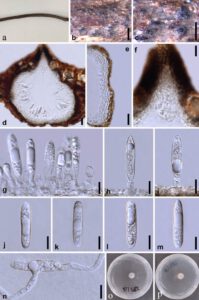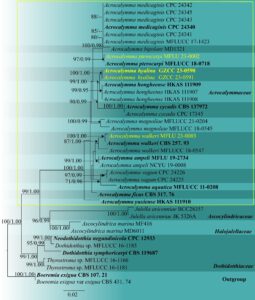Acrocalymma hyalina N. Wu, Jian K. Liu & K.D. Hyde sp. nov.
Index Fungorum number: IF 900557; Facesoffungi number: FoF 14276; Fig. 1
Etymology – From the Latin “hyaline” in reference to the hyaline conidia.
Holotype – GZAAS 23-0591
Saprobic on decaying branch of an unidentified host. Asexual morph: Coelomycetous. Conidiomata 160–230 μm high, 190–230 μm diam. (x̄ = 190 × 212 μm, n = 10), solitary or aggregated, immersed, partially erumpent when mature, dark brown to black, more or less circular, uniloculate, thick-walled, wall composed of outer layers of thick-walled, dark brown textura angularis, inner layers of thin-walled, hyaline textura angularis. Ostiole circular, central, papillate. Peridium 17–27 μm wide, composed of 5–6 layers, with outer 3–4 layers brown, thick-walled cells of textura angularis and inner 1–3 layers hyaline, thick-walled cells of textura angularis. Conidiophores reduced to conidiogenous cells, arising from all around the basal region of the conidioma. Conidiogenous cells 6–12 μm long × 5–8 μm wide, cylindrical, sometimes slightly curved, phialidic, hyaline. Conidia 30–38 × 5–9 μm (x̄ = 34 × 8 μm, n = 20), oblong to subcylindrical, straight, hyaline, aseptate, guttulate, not constricted or slightly constricted at the middle. Sexual morph: Undetermined.
Culture characteristics – Conidia germinating on PDA within 12 h. Colonies reaching 10 mm diam. after one week at 20–23 °C, circular, slightly raised, surface smooth, entire margin, white in surface view.
Material examined – Thailand, Chiang Rai Province, Phaya Mengrai District, Mae Pao, 19°53’5”N, 100°5’37”E, on an unidentified dead wood, 7 January 2020, Na Wu, YW285 (GZAAS 23-0591, holotype); ex-type living culture, GZCC 23-0590; ibid., YW284 (GZAAS 23-0592), living culture GZCC 23-0591.
GenBank numbers – GZCC 23-0590 – ITS: OR052071, LSU: OR052054; GZCC 23-0591 – ITS: OR052072, LSU: OR052055.
Notes – Phylogenetically, this collection resides in the genus Acrocalymma and is closely related to A. hongheense (Fig. 5). Our isolate is morphologically similar to A. hongheense (strain HKAS 111907, HKAS 111908 and HKAS 111909), but A. hongheense has 1-septate conidia (Mortimer et al. 2021). In addition, the conidial size of A. hyalina (30–38 × 5–9 μm) is bigger than that of the A. hongheense ex-type (20–35 × 7–9 μm, HKAS 111909). Regarding the nucleotide comparison, A. hyalina and A. hongheense differed in five base pairs (bp) in the ITS region, and six in the LSU region. Thus, based on phylogenetic inference supported by morphological observations, we introduce this species as a new Acrocalymma species.

Fig. 1 – Acrocalymma hyalina (GZAAS 23-0591, holotype). a Host substrate. b, c Conidiomata on the host. d Section through a conidioma. e Peridium. f Ostiole with periphyses. g–i Conidiophores and conidia. j–m Conidia. n Germinating conidium. o, p Culture on the PDA from the surface (o) and reverse views (p). Scale bars: b = 50 μm, c–e = 20 μm, f–n = 10 μm.

Fig. 2 – Phylogram generated from the maximum likelihood analysis based on the combined LSU, SSU and ITS sequence data. Thirty-nine strains are included in the combined analyses. Tree topology of the maximum likelihood analysis is similar to the Bayesian analysis. The best RAxML tree with a final likelihood value of -6868.654138 is presented. Evolutionary models applied for all genes are GTR+G. The matrix had 483 distinct alignment patterns, with 28.24% of undetermined characters or gaps. Bootstrap support values for maximum likelihood greater than 70% and Bayesian posterior probabilities greater than 0.95 are given near nodes, respectively. The tree was rooted with Boeremia exigua (CBS 107. 21) and B. exigua var exigua (CBS 431. 74). Ex-type strains are in bold. The newly generated sequences are indicated in yellow.
